Plume de Ville
Libellules.
°°°°°°°°°°°°°°°°°°°°°°° °
June 2009
June 1st
Patrolling, Patrolling...
Downy
Emerald. [Cordulia aenea - Corduliidae cordulia]
(La Cordulie bronzée)
Now this is a fidget! It is the male. Tirelessly he patrolled along the
riverbank in rapid flight. Lots of patience to succeed in catching it
in a
picture. Fortunately, it repeats roughly the same route again and
again. Except
for a few dazzling flights to hunt an intruder, it hovers briefly from
time to
time almost in the same locations. So if we manage to remember well the
route in
its territory, we end up retaining its routine and salvage a few
photos. I have
not seen it perched.
Metallic
green with beautiful shades of bronze. Very beautiful with its saffron
wings (not
well visible in
this the photo but under
some lighting in the sun is shimmering). Head completely green, without
yellow
markings.
(50mm)
Thorax covered with long coppery hairs.
The male has a slightly club-tailed abdomen.
Poor picture, but the green head is apparent. Tip of the abdomen is bronze. A short instant, puzzled, it changed direction and came to see who was watching it on the bank.
Just
for
fun I transcribe here one of course. On the right of an iris bed.
Flight right
around the iris, detour towards the bank, short hover, and fly away
from the bank,
back left, bypassing the iris, small hover at the left of the iris,
quick flight
to the far left encroaching largely on the bank. Back to water, short
hover,
still left, back in front of me, short hover and here again to the
right.
(Ph. Seine et Marne 19-200509)
2 June
Emperor
[Anax
Imperator - Anax -] (Anax empereur).
This female Anax has traversed throughout the large pond lengthily,
pausing a
few seconds on the leaves of water lilies and leaving immediately. I do
not
know if at every stop it lay; the stops where too brief to be sure.
Finally,
it settled for a leaf where it remained a comfortable minute to lay
quietly but a little too far from the objective.
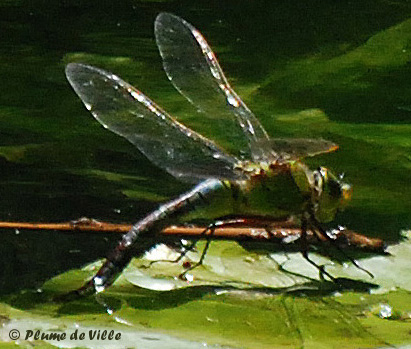
Thorax uniformly green as the male and abdomen taking dark purple stains on blue background.
(Ph. Seine et Marne 290509)
3 June
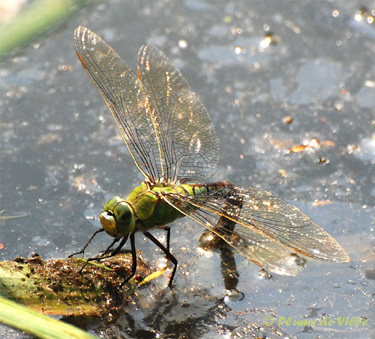
Another female Emperor, which had the kindness to come to lay just along the bank.
After being very annoyed by a broad-bodied chaser male which has established its territory there, which was in very bad mood and not at all willing to share, she finally found a quiet spot behind a clump of vegetation, out of sight of the spot "owner"... but well in view of the objective.
In search
for a spot to lay, it flies abdomen curved downward.

Nearby the downy emerald patrols relentless ... and follows nearly the same circuit!
(Ph. 030609)
4 June
Four-spotted
chaser.
[Libellula quadrimaculata - - Libellulidae -]
(Libellule à quatre taches)
Dark triangle at the base of hind wings with yellow veins very
pronounced.
Four dark spots on the wings.
This is an immature male, it is young.
Later it will become darker.
Tapered abdomen with yellow sides and beautiful eyes.
The
four-spotted
chaser alight to watch its territory on an overhanging stalk or, better
still, on
a yellow iris. Thank to it for its choice.
Female not seen.
From time
to time it takes off for a survey of the area and returns gently to
perch in
the same place.
(Ph. 290509)
Five
days
later (no, of course, this is not necessarily the same one, but it was
in the
same place).
He lost his beautiful golden colour. It is darker with a "scales"
abdomen.
On this zone of the pond it is in conflict with the broad-bodied
chaser. They both
covet the same perch. He won the perch temporarily, the broad-bodied
chaser
turns around the pond, a few seconds latter it will come back to chase
it. The
turn of the four-spotted chaser to make a turn and come back and ... so
on.
In the end it is the broad-bodied chaser which will win. The
four-spotted
chaser will settle on a tuft of grass in the middle of the pond.
(Ph. 030609)
8 June
A beautiful
meeting.
Red-veined
darter.
[Sympetrum fonscolombii
- Libellulidae
Sympetrum -] (Sympetrum
à nervures
rouges, Sympetrum de Fonscolombe).
It is red,
red, shiny. Red is still accented by its red veins at the base of its wings. It
boasts large bright orange pterostigmas lined with a black streak.
The
underside of its eyes is blue-grey.
Its face is bright red.
It usually has a small yellow spot on the hind wing but I must say that
on this
beautiful male is not apparent. Now I believe that some individuals
don't have it
or scarcely visible.
Yellow striped Legs.
Here
it is in
Paris, but probably transient, it's not his habitat.
It comes from warm regions, Africa, Asia, Mediterranean regions.
With just 3-4 cm long it is a long haul traveller!
Resident in the Mediterranean region can undertake extensive northward
migrations
but rarely and irregularly. This one is probably transient and made a
stop on
the stair stones, heated by the morning sun.
Their eggs hatch quickly and there may be several generations per year.
Its female has shades of yellow, but has the same characteristic blue
under the
eyes.
(Ph. Paris 290509)
9 June
Beautiful
demoiselle.
[Calopteryx virgo - Calopterygidae - Calopteryx] (Caloptéryx
vierge)
A small stream shaded by trees, muddy bottom,
they were there, tens to play in
the sun on tiny sandy beaches. So on this page a large dozen too, it is
too
much, of course, but the show was so beautiful.
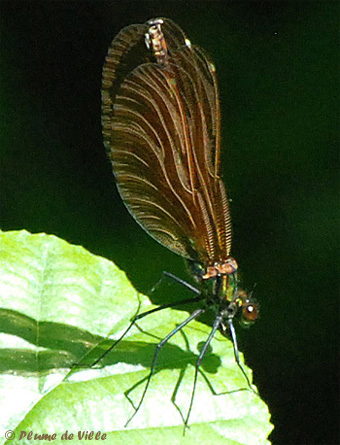
In
contrast
to the banded demoiselle, male wings are almost entirely dark blue,
cobalt.
Only the wing tip is transparent. Females are difficult to recognize
compared
to females banded demoiselle but here it is not much a problem...
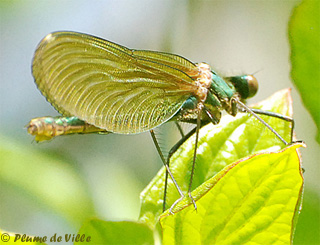
Here the
female banded demoiselle which give me some trouble earlier, that
present here
for comparison.
The
female
wears beautiful pseudopterostigmas (the small white spot on the wing
not
delimited by veins), away from the wing tip.
Depending
on lighting, the male may appear entirely blue.
The
male
spreads the wings from time to time, deterrence and/or parade.
Below: this female is not in very good shape. Probably an aged female. It took shades of copper, amber eyes and its wings are damaged.
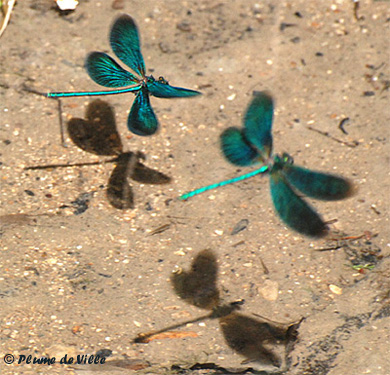
When the males parade, flit and bicker in the sun, the spectacle is magnificent. They do not touch but dance one around each other, to show at their best advantage
Here
we see
the transparency at wing tip and a small transparency at the base of
the wings.
Sure, video would be better! Difficult to keep them in a photo.
Who could resist it? It is so beautiful in parade.
This demonstration is for females, it thus shows the underside of its
abdomen
with the tip is red for "beautiful", (yellow for "banded")
but I have not had the opportunity be on the good side!
(Females are on the bank opposite to the photographer.)
Females attend perched on the foliage, enjoying the spectacle, the males move around them and eventually stop, finally accepted.
The
installation requires a bit of gymnastics and nice balance.
After mating (three minutes), a moment of rest for the female. The male had immediately returned to new conquests.
Brief,
because the female will lay eggs immediately after mating, alone,
without the
aid of the male.
This one is the same female as in the above photos.
It will be disturbed several times by other males and will change
places and
leave this sunny corner for a place a little more hidden, less
favourable to
the picture. It will take six minutes to finish its laying.
Spawning is completed, it will return to settle on a leaf.
It pierces the
twig at regular intervals to deposit its eggs, shifting gradually its
abdomen.
Twenty seconds between the two photos.
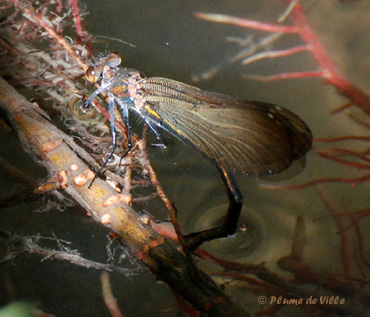
(Ph. 220509 - 020609)


